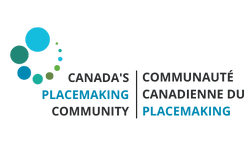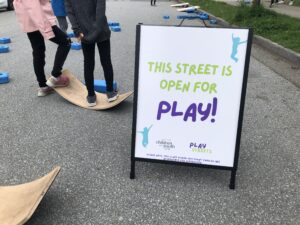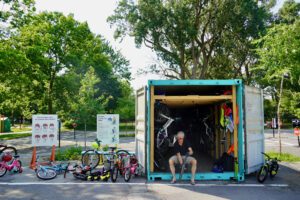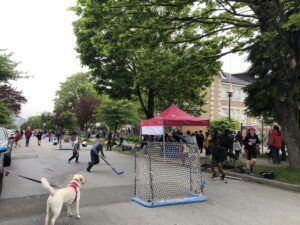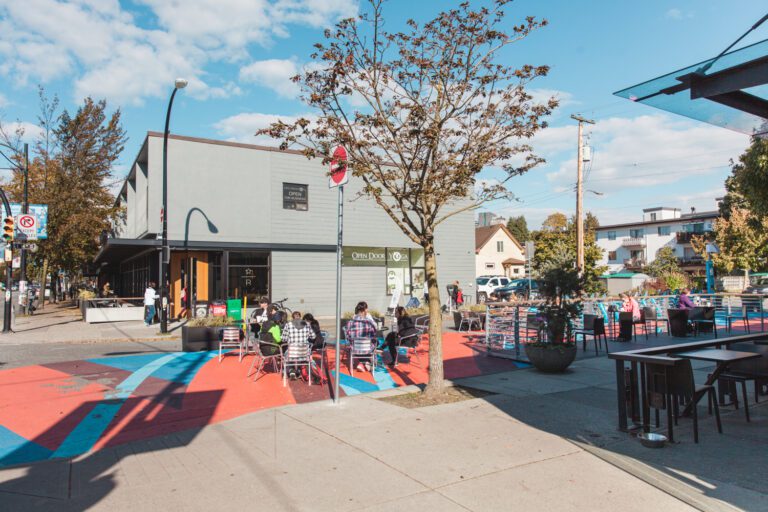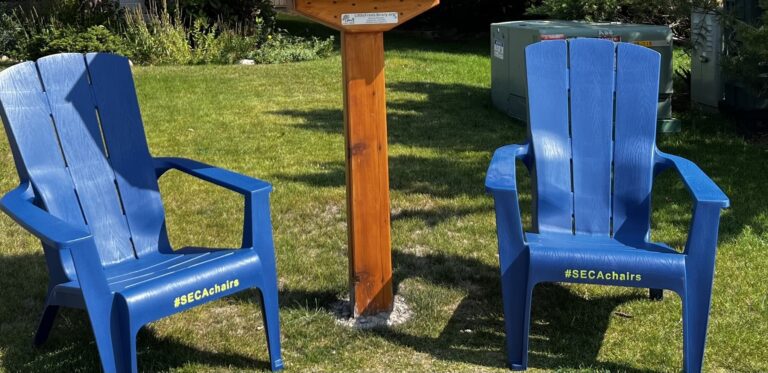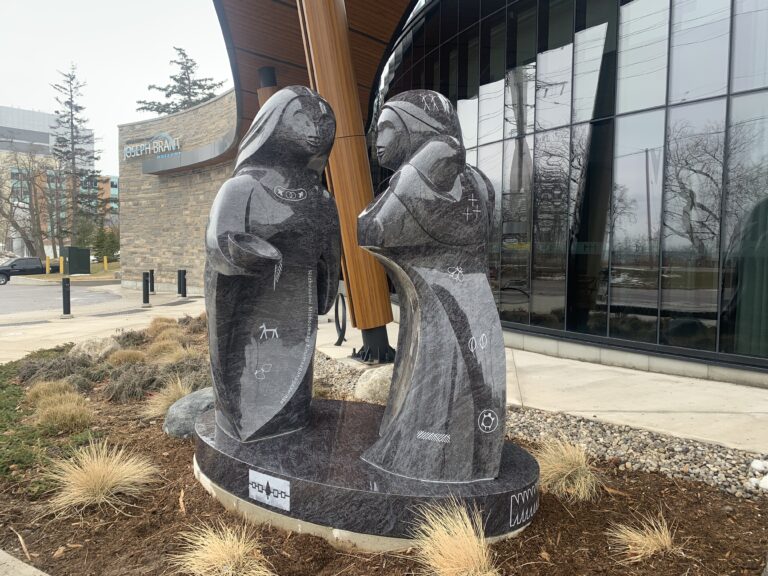Children playing on play structure in public park by Lake Ontario. Photo: Oakville News
This article is the first in a five-part series exploring the connections between placemaking and community wellbeing, written by Canadian Healthy Communities’ Placemaking Community (facilitated in partnership with the Canadian Urban Institute) and Happy Cities. Building on the Power of Placemaking project and our Community Conversations, this article shares learnings about how placemaking initiatives, including those that have been funded and supported by CHCI, can support mental and physical health in our communities.
This is what we heard through conversations with practitioners shaping spaces across Canada.
How Placemaking Positively Impacts Our Health
By: Eva Morrison
The places we spend time in are deeply connected to our mental and physical health, from home to work, school, the gym, and everywhere in between. So how can we ensure that our shared spaces—like the streets, parks, and transit routes we use everyday—promote positive health outcomes?
Placemaking is an evolving concept centred on the collective reimagining and reinventing of public spaces to enhance health, happiness, and wellbeing. From promoting physical activity with bike lanes along main streets, to reducing loneliness through accessible neighbourhood events, placemaking initiatives can shape public environments to foster healthier communities.
During our Community Conversations, an initiative led by the CPC, with placemakers representing neighbourhoods across Canada, we learned about the diverse ways that initiatives are transforming public spaces to benefit community health. We heard that placemaking projects can enhance both mental and physical health by building shared spaces for play and connection, improving walkability, and creating connections with nature.
The Vancouver School Streets project. Photo: Happy Cities
Building Shared Spaces for Play and Connection
Do you remember the spaces where you played outside as a child? In one group discussion with placemakers, we asked participants to think about a time and place when they felt socially connected and physically active in their childhood. Participants recalled fond memories of playgrounds as key places where they could build friendships and exercise as children. For example, one participant described the local playground as an “essential gathering space” where kids would flock immediately after school.
Creating spaces where people can gather, play, and connect is vital to community health. Placemaking initiatives—like open streets, interactive public artworks, and recreational activities for community members—can promote an active, playful lifestyle which boosts self-esteem and reduces stress. Public spaces for play can also promote physical activity for youth, a key factor in healthy childhood development and preventing obesity.
Play doesn’t just happen on playgrounds. Placemakers are developing other creative spaces for play that can positively benefit children’s emotional and physical development.
A bicycle learning park. Credit: Vélo Québec Association
Healthy Communities Initiative (HCI) funding recipient Sport et Loisir de l’île de Montréal (SLIM) prioritizes recreational outdoor activities that are accessible, innovative, and equitable to promote community health on the island of Montreal. One of the supported initiatives, created in collaboration with Vélo Québec, is a bicycle learning park that provides learning opportunities for children to bike safely while fostering a community of young families and kids.
And it’s not just about kids—play is for everyone. Ice rinks are another shared public space that welcome play at all ages in many communities across Canada. The River Valley Community Centre in New Brunswick received funding from HCI to develop outdoor recreational spaces for community members of all ages. The organization also created a snowshoe lending library and a multi-generational recreation space, informed by community members and students. These facilities keep the community active throughout the Canadian winter, promoting both physical health and social interaction.
Low-barrier and free public programming create equitable spaces where anyone can live, play, and work outside. The Canada Healthy Communities Initiative funded placemaking projects that break down barriers so their communities can comfortably access their public spaces. Activities that are low-cost and publicly accessible like a snowshoe lending library, free bicycle training, or eco-education workshops can promote equitable health outcomes by allowing more people to participate.
Emma Clayton Jones from the NORC Innovation Centre highlights the role of placemaking in supporting social connectedness for aging populations.
“We learned through this work that the ability to gather with those around you is really tied to health outcomes,” said Jones. “Opportunities to get out and mix with different age groups are essential. Our interest in placemaking is, ‘How can we make our life bigger and more connected as we age?”
Our social connections are important to our mental and physical health at all stages of life, from fostering healthy development on the playground to giving us a sense of community as adults. Placemaking initiatives that create spaces for these connections can build healthy communities.
Encouraging Walkability and Active Transportation
Placemaking also supports health by integrating physical and social activities into our everyday routines, like the transit spaces we use daily to get from point A to point B. This involves putting people first in the design process to create safe and vibrant streets.
We asked participants to imagine what their local streets would look like without cars. Would you be able to pick up groceries, go to the park, or meet with friends? Placemakers collectively imagined spaces where walkability and active transportation are put first, contributing to cleaner air and a healthier environment. As one participant said, “We’re designing spaces that prioritize people over vehicles, making it safer and more enjoyable to walk.”
The School Streets program in Vanouver. Photo: Happy Cities
In several communities, this people-centered approach has inspired a “walking school bus,” where children walk to school together with adult supervision. One participant recalled a heartwarming example from the Sunshine Coast in British Columbia, where seniors volunteer to create safe walking experiences for kids in a program that not only promotes physical activity but also fosters community bonds.
Vancouver’s School Streets program proves that making space for active transport can connect communities. When the City closed several street blocks outside of six elementary and high schools at drop-off and pick-up times, 33% of students reported walking more. And it didn’t just boost physical movement—82% of people reported that the School Streets, with games and play activities, made them feel more connected to their community.
Creating Connections with Nature
Another way that placemaking can support community health is by bringing people closer to nature (physically or emotionally). Access to nature can encourage physical activity and even lower your blood pressure. Studies show that time in nature can improve cognitive performance, alleviate the effects of mental illness, and improve overall wellbeing.
Nature-based education initiatives are one way to build healthy communities that are connected with the natural world. Francie Morgan from Nature NB emphasizes the importance of eco-education for newcomers, who might not be familiar with the local environment or may be interested in learning more.
“Regardless of where we were born and how we were raised, it is our birthright as human beings to have a relationship and connection with nature,” said Francie. “Through our programming, we aim to open the doors and create opportunities for folks to get to know and appreciate the nature in their own backyards.”

Plants sprout at an urban farm. Photo: Markus Spiske
Our Power of Placemaking research found that when community members are involved in bringing public spaces to life, they feel a sense of ownership and agency. Having pride in your neighbourhood–whether it comes from growing community gardens, contributing to a mural, or bringing a friend to your local park– encourages people to take care of these areas over time, contributing to a sustainable community.
Access to natural food sources can also significantly improve physical health. Many placemaking programs address this need by facilitating group gardening activities. Getting your hands dirty in the process of growing food can build a sense of pride and ownership of community gardens.
In Toronto’s high-density neighborhoods, grassroots initiatives like the Thorncliffe Park Urban Farmers engage the community in urban farming. A resident and worker in this area shared her experience.
“It’s amazing to see the community come together in the spring and summer to tend to the urban farms in parking lots,” she said. “The harvest is shared among those helping, promoting both physical health and community spirit.”
Placemaking initiatives are powerful tools for enhancing community health, both physically and mentally. Shared spaces that put people first, encourage playful social connections and help foster our relationship with nature can have a big impact on our wellbeing. As our cities continue to grow, community-led placemaking strategies can use these approaches to shape healthier, more connected, and resilient communities.
Learn more about the wellbeing benefits of community-led placemaking initiatives in the Power of Placemaking research report, developed in partnership with Happy Cities. Find and download resources from the report to help you make the case for placemaking in your community!
